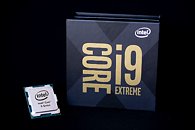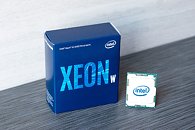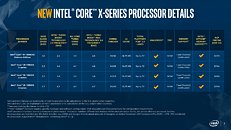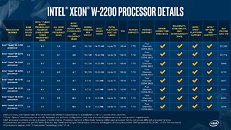Monday, October 7th 2019

Intel Announces 10th Gen Core X Series and Revised Pricing on Xeon-W Processors
Intel today unveiled its latest lineup of Intel Xeon W and X-series processors, which puts new classes of computing performance and AI acceleration into the hands of professional creators and PC enthusiasts. Custom-designed to address the diverse needs of these growing audiences, the new Xeon W-2200 and X-series processors are targeted to be available starting November, along with a new pricing structure that represents an easier step up for creators and enthusiasts from Intel Core S-series mainstream products.
Intel is the only company that delivers a full portfolio of products precision-tuned to handle the sustained compute-intensive workloads used by professional creators and enthusiasts every day. The new Xeon W-2200 and X-series processors take this to the next level, as the first high-end desktop PC and mainstream workstations to feature AI acceleration with the integration of Intel Deep Learning Boost. This offers an AI inference boost of 2.2 times more compared with the prior generation. Additionally, this new lineup features Intel Turbo Boost Max Technology 3.0, which has been further enhanced to help software, such as for simulation and modeling, run as fast as possible by identifying and prioritizing the fastest available cores."The professional and enthusiast communities require product engineering that caters to their specific mission-critical needs and keeps them on the cutting edge of technology advancements. This means the best hardware and software optimizations, but also looking at how we can infuse things like AI acceleration," said Frank Soqui, Intel vice president and general manager of Desktop, Workstation and Channel Group. "No matter if you are a data scientist, cinema creator or freelancer, Intel Xeon W and X-series offer power and flexibility of choice, enabling you to keep working creatively and competitively across even the most intensive workloads."
For professional creators, the Intel Xeon W-2200 platform is the ultimate option. These eight new processors (W-2295, W-2275, W-2265, W-2255, W-2245, W-2235, W-2225 and W-2223) deliver outstanding performance and expanded platform capabilities for data science, visual effects, 3D rendering, complex 3D CAD, AI development and edge deployments. They can be used in configurable form-factors - from small desktop to towers - as well as include built-in platform security features and reliability, such as ECC support and Intel vPro, which creative professionals demand. For example, the 3D architectural rendering process on Autodesk Revit with V-Ray accelerates up to 10 percent faster compared with the previous generation and up to 2 times faster compared with a 3-year-old workstation.
New Xeon W prices range from $294 to $1,333, enabling Intel to build the platform and partners to grow their workstation product options.
In addition to Intel Xeon W and X-series, Intel is also introducing new pricing to its Intel Core S-series processors without integrated graphics. Intel is committing to these processors in its long-term roadmap, which has given Intel the opportunity to reset where it fits in the portfolio and pricing. The new prices are effective starting today, with the 9th Gen Intel Core desktop processors currently in market.
Intel is the only company that delivers a full portfolio of products precision-tuned to handle the sustained compute-intensive workloads used by professional creators and enthusiasts every day. The new Xeon W-2200 and X-series processors take this to the next level, as the first high-end desktop PC and mainstream workstations to feature AI acceleration with the integration of Intel Deep Learning Boost. This offers an AI inference boost of 2.2 times more compared with the prior generation. Additionally, this new lineup features Intel Turbo Boost Max Technology 3.0, which has been further enhanced to help software, such as for simulation and modeling, run as fast as possible by identifying and prioritizing the fastest available cores."The professional and enthusiast communities require product engineering that caters to their specific mission-critical needs and keeps them on the cutting edge of technology advancements. This means the best hardware and software optimizations, but also looking at how we can infuse things like AI acceleration," said Frank Soqui, Intel vice president and general manager of Desktop, Workstation and Channel Group. "No matter if you are a data scientist, cinema creator or freelancer, Intel Xeon W and X-series offer power and flexibility of choice, enabling you to keep working creatively and competitively across even the most intensive workloads."
For professional creators, the Intel Xeon W-2200 platform is the ultimate option. These eight new processors (W-2295, W-2275, W-2265, W-2255, W-2245, W-2235, W-2225 and W-2223) deliver outstanding performance and expanded platform capabilities for data science, visual effects, 3D rendering, complex 3D CAD, AI development and edge deployments. They can be used in configurable form-factors - from small desktop to towers - as well as include built-in platform security features and reliability, such as ECC support and Intel vPro, which creative professionals demand. For example, the 3D architectural rendering process on Autodesk Revit with V-Ray accelerates up to 10 percent faster compared with the previous generation and up to 2 times faster compared with a 3-year-old workstation.
New Xeon W prices range from $294 to $1,333, enabling Intel to build the platform and partners to grow their workstation product options.
In addition to Intel Xeon W and X-series, Intel is also introducing new pricing to its Intel Core S-series processors without integrated graphics. Intel is committing to these processors in its long-term roadmap, which has given Intel the opportunity to reset where it fits in the portfolio and pricing. The new prices are effective starting today, with the 9th Gen Intel Core desktop processors currently in market.





11 Comments on Intel Announces 10th Gen Core X Series and Revised Pricing on Xeon-W Processors
Jacking up cores, The Ripper™ coming for a third (and probably final) time will most definitely kill the heart of Intel's HEDT pretty fast. It's just that Intel had to decide whether or not taking some narcotics for the sake of numbness beforehand – or actually really wanting to attend TR3's bloodbath in person. Seems with that price-cut they just took the pill – to make it less bloody.
Smartcom
As for 32 cores, it depends on software support and most prosumer grade applications have troubles utilizing anything past 16 threads or can't run at all past 32 threads.
So to put an end to this myth, no, there is no such thing as having "trouble utilizing" threads after a certain number, these things are not static. The threads are utilized just fine, the scaling simply varies due to various other reasons such as memory bandwidth. In other words, most of the time the software is designed to scale indefinitely, the hardware isn't.
www.gamersnexus.net/guides/3460-new-cpu-bench-methodology-workstation-program-compile-tests-premiere
For a decade no company got even close to their performance and production capabilities.
And it wasn't a gov-established monopoly.
Everyone could get on board, buy IP from AMD and make x86 if it's such an easy and profitable business. :-)
You shouldn't look at this as Intel "ramming you up". They were the only company that took the risk, so they could ask whatever price they wanted - just optimizing for earnings. And since they asked a lot, it means customers must have been fine with paying that much.
Now we once again have two suppliers of high-end x86 CPUs and naturally the prices have to go down. If they didn't, it would mean Intel was asking too little for all these years.
The only interesting question is: what level of prices is this business going for?
Will it remain a high-margin business (near what Intel used to make) - full of dream jobs and excellent salaries - or will it be a less prestigious, poor business with very low margins (like what AMD asks today)?